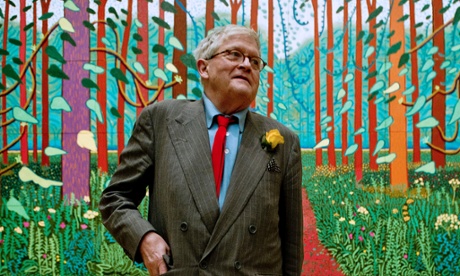
David Hockney’s biographer has neatly divided his life in half, representing him in youth as a libertine hellbent on pleasure, then in middle age as a higher-minded truth-seeker. Sykes’s initial volume was subtitled A Rake’s Progress; this follow-up is billed as A Pilgrim’s Progress.
In fact, Hockney never bore much resemblance to Tom Rakewell, the wastrel in Hogarth’s satirical narrative. In his etchings of his own supposedly rakish progress across America in the early 1960s his depravity doesn’t extend beyond peroxiding his hair and ogling muscular customers in a gay bar. The latter-day Hockney is equally unlike Bunyan’s religious pilgrim, and his version of the Celestial City to which Christian travels is Los Angeles, populated by “shining ones” who are not angels but golden-skinned beach boys.
Though I’d question the way Sykes allegorises Hockney’s life, I agree that it has been an unstoppable progress, a serial self-renewal. Hockney has an endearing childishness: hence his sympathy with the rampaging infant in Ravel’s L’enfant et les sortilèges, which he designed for the Metropolitan Opera in 1981. Growing up, Hockney has so far only got to geeky teenage, and in Sykes’s second volume he emerges as an adolescent early adopter, elated by a succession of modish gadgets – the Polaroid camera, Quantel’s computerised Paintbox, Canon’s photocopier, the fax machine, Sony’s Handycam, most recently the iPhone and iPad – which he twists into pictorial tools.
With his mismatched socks, chequered caps and hearing aids paired like earrings, he belongs, as Sykes points out, to a venerable English tradition of eccentricity – but there’s also a wilder-eyed cerebral obsessiveness to the man, which explains his preoccupation with the link between technology and vision and his wonky autodidactic theorising. Christopher Isherwood likened him to “a mad scientist”. A decade ago, he made a doomed attempt to prove that Renaissance painters used photographic lenses when drawing faces. “It’s what I think that counts,” he groused when no one believed him.
Hockney’s fixation on work has left little time for the rest of life, and Sykes even has to shoehorn the death of his adored mother into an account of the optical experiments that currently absorbed him. On holiday in India, he quarrelled with his dealer, Kasmin, and decided to fly back to London. Kasmin was sent to rebook their flights, but on returning to the hotel he found that Hockney had cheered himself up by completing “a rich picture of his briefcase and panama hat” – a little parable of solipsism as a homeopathic remedy.
Though deafness has left Hockney isolated, in earlier days he was chaotically gregarious, holding open house in studios where the phone rang constantly while drops-ins nattered, gofers bustled about, and motherly muses like Celia Birtwell brewed pots of Typhoo. But this conviviality masked a colder autonomy. Hockney collected people because he needed models, not friends; intimacy was repaid by service, and his long-term partner, John Fitzherbert, was first hired as a cook. In 1986 Hockney tried to cajole Birtwell into moving from London to live beside him in LA. “Selfish cunt,” remarked Ossie Clark, father of the children Birtwell was expected to uproot. Erstwhile boyfriends who confide in Sykes all comment on Hockney’s emotional unavailability. Fitzherbert remarks that when he wants to validate their relationship he looks at Hockney’s portraits of him; no reassurance can be expected from the man himself.
Perhaps Hockney only ever enjoyed reciprocal bliss when cuddling his pet dachshunds; he admired and perhaps envied the dogs because they remained all their lives in a dependent unweaned infancy.
Apart from canine tongue-kisses, Hockney’s closest relationship is with his mother, and the quotes from her diaries are a particular joy. Away from Bradford, she was touchingly bemused by the wider world: she gaped at the shower in her Savoy bathroom without daring to use it, and in LA she wondered why, in this beatific climate, people didn’t hang their washing out to dry. Yet her grounded good sense made her an incisive critic. At a Hayward gallery exhibition, she cast an appraising eye on an installation of coiled rope by Barry Flanagan, then asked “Did he make the rope?” The question, as her son noted, deftly deflated the pretensions of conceptual art.
Sykes is an amiable, unanalytical chronicler, who flogs dead metaphors without mercy: he reports that Hockney was “blown away” by New York, then adds that he was “blown away” by LA as well. Cutting and pasting sources, he makes it seem as if a grumpy review I wrote of Hockney’s designs for The Magic Flute at Glyndebourne in 1978 drove him into exile. Later in the same paragraph, he reveals that Hockney actually left for LA in a huff because English pubs closed early; in 2003, still huffy, he returned to Yorkshire because California had outlawed smoking in public places. Anything that obstructs Hockney’s instincts is intolerable: as Kasmin put it, “David’s ego is so large his self-pity is commensurate.”
Pilgrimages have goals, places of rest where the believers can worship at a shrine. So far, Hockney’s journey has no end in sight, and at the age of 77, despite depressive slumps, a heart attack, recurring pancreatitis and a nicotine habit, he considers that he is still in what he calls “my middle period”. He may not provide Sykes with enough material for a third volume, but I expect there will at least be a lengthy supplement to this one.

